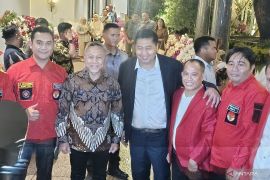The target is part of the eight MDGs, namely Eradicating extreme poverty and hunger; Achieving universal primary education; Promoting gender equality and empowering women; Reducing child mortality rates; Improving maternal health; Combating HIV/AIDS, malaria, and other diseases; Ensuring environmental sustainability; and Developing a global partnership for development.
The Indonesian government has incorporated the MDG target in its national program for drinking water and sanitation. The nation, however, has to work hard to implement the program because more than 100 million people in Indonesia lack access to safe drinking water.
Public Works Minister Djoko Kirmanto said recently the government will boost the performance of the National Water Resources Council to help meet the target of MDG in clean water supply coverage at 68 percent. The country`s clean water supply coverage reaches 55 percent currently.
Adequate water supply is important to boost rice production which is part of the national food resilience program. According to Minister Kirmanto, the government has targeted to reach rice production surplus at 10 million by 2014, arid land rehabilitation at 2.5 million hectares, and hydroelectric renewable energy.
For that purposes, the Indonesian government will improve the infrastructure and facilities of clean water supply and repair the irrigation system, said National Development Planning Minister Armida Alisjahbana.
Coordination between the central and regional governments must be intensified for the improvement of clean water supply infrastructure and irrigation system, the minister, who is concurrently the head of the National Development Planning Agency (Bappenas), stated in Jakarta, on January 31, 2013.
"The target of clean water pipe network is 68 percent by 2015, and now it is 55 percent at the average. So there is a gap of 13 percent that we have to cover," she said.
A total budget amounting Rp65.27 trillion comprising Rp12 trillion from the government and Rp53.27 trillion from investors, is needed to achieve the target of 68.87 percent in clean water supply coverage.
The clean water supply coverage is low because most of the country`s clean water supply companies are not in healthy condition financially, and several of them are currently being restructured as a precondition to be entitled to receive credit.
Chairman of the Association of Clean Water Supply Companies in Indonesia (PERPAMSI) Syaiful last year said the country`s 410 clean water companies were able to supply clean water in urban areas at 41.88 percent and in rural areas at 13.9 percent, or at the average of 27 percent.
Until 2011, only 55.04 percent of the total population have access to clean water supplies. "It`s still far from the target of MDGs by 2015 at 68.87 percent," he said.
Many of the Regional Water Supply Enterprises (PDAM) are not well managed as a result of limited human resources. Idle capacity is also a problem which reaches 15% of the installed capacity. Untraced use of water in average is high reaching 40 percent of total water usage.
Vice President Boediono in January 2013 reminded district and city administrations to provide clean water as basic necessity for the public.
Local administrations were also responsible for treating liquid waste, Vice President Boediono said in his opening speech in the Indonesian Water and Waste Water Expo and Forum 2013 in Jakarta, earlier this year.
District and city administrations must cooperate with the central government in providing clean water as basic need, he stated.
The Indonesian government has been committed to achieving the MDGs in order to increase the dignity of the Indonesian people, he stated, adding that providing clean water is one of the main goals.
Boediono encouraged local officials to establish public and private partnership in developing clean water supply and waste water treatment facilities.
Regarding the status of regional clean water supply companies, of the existing 335 companies throughout Indonesia, 144 are categorized as healthy companies, 105 less healthy and 85 unhealthy, according to the vice president.
Ignasius DA Sutapa, a fresh water researcher at LIPI (Indonesian Institute of Sciences) said in Bengkalis, Riau, sometime ago that Indonesia has the worst drinking water in Southeast Asia.
"Only 30 percent [of city residents] have access to clean water. (That number) drops to only ten percent in villages," he said.
Indonesia needs to ensure that at least 50 percent of the population has access to clean drinking water if the nation hopes to meet the targets set by the United Nations` MDGs.
Reaching Indonesia`s clean water target it too large a goal for the state-owned water company PDAM to meet alone, Ignasius said. The government should focus on building more peat water processing plants in peatland-heavy areas like Sumatra, Kalimantan and Papua, he added.
Inland waters in Indonesia covering areas of 534.000 km2, consists of 394.000 km2 swampy areas, 119.500 km2 catchment areas and flood plains, 16.000 km2 man-made lakes and 5000 km2 natural lakes.
There are 521 lakes, of which 14 of them have more than 100 meters depth, eight lakes with more than 200 meters depth, and three with more than 400 meters depth.
The biggest lake are 1.130 km2 wide with 590 meters depth. Totally, these lakes contains 500 km3 freshwater, according to an article on "Fresh Water Country Profile: Indonesia" posted on the UN website (www.un.org).
As a whole, freshwater is abundant in Indonesia reaching an average annual quantity of 15,500m3 per capita; the availability of freshwater is quite huge, about 25 times when compared to that of the world which is only about 600 m3 per capita annually.
Such abundance of freshwater is however not evenly distributed within the country and furthermore, the availability also depends on the seasons, the profile said. ***4***
(Writing by Fardah; Editing by Bustanuddin)
(T.F001/A/F001/B003) 01-02-2013 18:36:49
Reporter: Fardah
Editor: Fardah Assegaf
Copyright © ANTARA 2013











